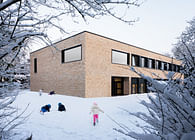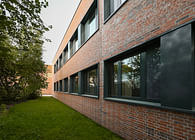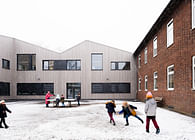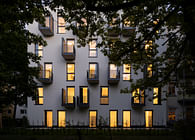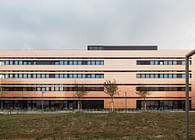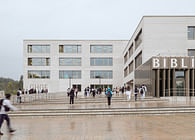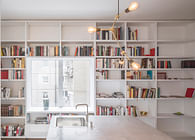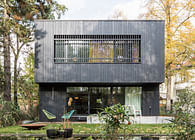
Sehw has had a passion for existing buildings, continuing construction, refurbishing and revitalising them — for over 25 years. Sehw architects are driven by the fascination of continuing the stories, rethinking spatial relationships and uncovering and revealing the qualities of the existing structures.
The Georg-Eckert Campus, designed by Sehw Architecture, is a modern research campus of the Georg Eckert Institute for International Textbook Research in Braunschweig, Germany, as part of the Leibniz Association. The project includes the construction of a new library and the refurbishment and upgrading of existing buildings. Villa von Bülow, a neoclassical building from the 19th century, is listed as a historical monument and has been carefully restored. The former nurses’ residence of the adjacent hospital, dating back to the 1970s, has been incorporated into the research campus, also refurbished and repurposed as an administrative building. A delicate glass bridge connects the new with the existing buildings, creating an exciting interplay between old and new and a dynamic sense of identity.
The two-storey library addition is the centrepiece and face of the ensemble. The ground floor features a transparent design, allowing views into the institute’s extensive book collection and glimpses of the park beyond. The upper floor is adorned with finely structured and perforated metal elements made of anodised aluminium, giving the building a light appearance amidst the greenery of the park and setting it apart from the plastered volumes of the existing buildings.
With a total area of approximately 1,600 m2, the new research library houses the world’s most extensive collection of international textbooks. Currently, this collection comprises around 183,000 print and online media from 180 countries. The library further complements this impressive collection with a scientific collection of approximately 80,000 print and online media. Thus, the campus provides an unparalleled resource for researchers, scholars and students from around the world.
An important aspect of the planning is the successful integration of the tree-filled park along the Oker River that runs through Braunschweig. The green areas are not only protected but also incorporated into the overall concept of the project. The campus thus creates a harmonious connection between the built environment and the natural landscape. The proximity to nature provides a pleasant working atmosphere and simultaneously emphasises the project’s ecological approach.
The sensitivity in dealing with the existing buildings, the preservation of the old tree population and our experience in handling highly significant monuments were crucial in the implementation of the project. Instead of demolishing the existing buildings, they were respectfully refurbished and integrated into the new ensemble. The result is a dynamic interplay of the individual buildings that makes the campus a driver of innovation for educational media research.
The architecture of the Georg Eckert Campus not only makes aesthetic statements but also places great emphasis on sustainability through energy efficiency and sufficiency. By utilising modern construction technologies and materials, solutions have been implemented to significantly reduce the campus’s energy consumption. The development of an innovative concept for natural and artificial lighting, in conjunction with the curtain façade of the library extension, reduces the need for artificial lighting, thus optimising energy usage. This not only lowers operating costs but also minimises CO2 emissions. Another focus is on sufficiency, that is the conscious reduction of resource consumption. By refurbishing and repurposing existing buildings, large amounts of building materials and energy were saved. The preservation of the historical structures and their integration into the new ensemble demonstrate that sustainable architecture also considers the protection of cultural heritage and the avoidance of waste and environmental impact, viewing existing building stock as a valuable resource. Through a holistic approach to energy efficiency, sufficiency and sustainability, the architecture of the Georg Eckert Campus contributes to an ecological and resource-efficient utilisation. This is evident both in lower operating costs and reduced CO2 emissions as well as in the campus’s role model function as a sustainable construction projects.
The Georg Eckert Campus was completed and officially inaugurated in 2022. The institute now boasts a research library with the world’s most extensive collection of international textbooks, providing optimal working conditions for its staff. Villa von Bülow serves as a meeting place between academia and the public, housing exhibition and event spaces that offer visitors insights into the history of educational media and the institute itself. With the new campus, significant milestones have been set for the future development of the Georg Eckert Institute.
Status: Built
Location: Braunschweig, DE

